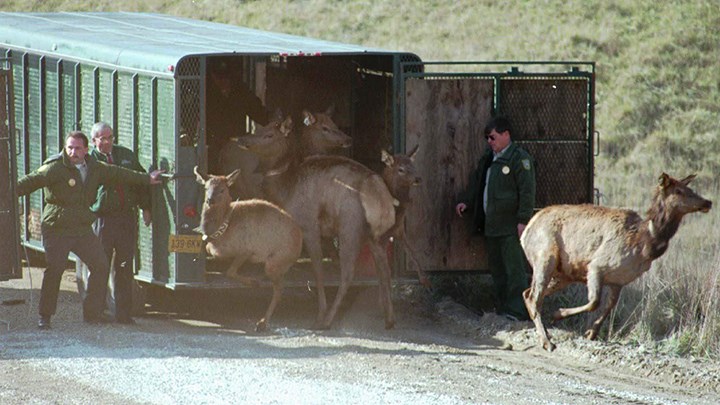
by Alan Peterson - Thursday, December 17, 2020

2020 has been an infamous year. Everyone has been affected by COVID, lockdowns, riots, bizarre politics and uncertainty. I know many of us can’t wait to have 2020 in the rearview mirror. But, even with all the storm clouds of the past year, with a little effort, you can find a silver lining.
One result of the uncertainty created by the COVID and riot-induced anxiety was record-smashing sales in firearms and ammo. Starting in March, sales and NICS submissions went through the roof. In addition to the millions of new gun owners added to the “Second Amendment Team,” every Glock and SIG and 870 and AR-15 that sold added more dollars to the historic conservation work happening around the country every day. And that goes for every 9mm round and shotgun shell and .22 Long Rifle round you purchased. Just by purchasing those items, you ensure that America’s wildlife and wild places will remain secure.
Through the Federal Aid in Wildlife Restoration Act of 1937—named for the bill’s sponsors, Nevada Sen. Key Pittman and Virginia Rep. Absalom Willis Robertson, and known as the Pittman-Robertson Act (P-R)—millions of firearm and ammunition buyers provide the largest financial resource for conservation in the world.
The U.S. Fish & Wildlife Service (USFWS) announced earlier this year that nearly $1 billion was raised in 2019 by sporting consumers through the Pittman-Robertson act and the Dingell-Johnson act (similar, fishing-based excise tax). During the announcement, Secretary of the Interior David Bernhardt stated, “Our conservation model is funded and supported by America’s hunters, shooters, anglers and boaters. These dedicated outdoor enthusiasts generated nearly a billion dollars this year alone and make our country's conservation legacy possible.”
Since 1939, over $22.9 billion has been raised by sportsmen and sportswomen, forever changing the face of conservation in the United States. No organization comes close to the impact of the P-R act—funded by hunters, shooters and archers. It was so effective that in 1950, the Federal Aid in Sport Fish Recreation Act (Dingell-Johnson Act) created a 10 percent tax on fishing gear to be used for waterways and fish habitat in like manner as the P-R funds for hunting and wildlife. Additionally, the states have matched those funds with $7.6 billion from your hunting and fishing license fees. 2020’s contributions to 80 years of P-R history are shaping up to be extraordinary.
According to information provided by the National Shooting Sports Foundation, NICS requests exceeded 19 million through the end of November (December data were not available at the time of publication). That’s up more than 7.5 million requests from the same time frame in 2019. That’s lots of new gun owners contributing to U.S. conservation with every purchase.
USFWS Director Aurelia Skipwith described this essential cooperative effort: “…the Fish and Wildlife Service is the linchpin in the circle of funding that arcs from the hunters and anglers generating these dollars as consumers, through the states as conservation managers, and back to hunters, anglers and recreational users as beneficiaries, for improved hunting, fishing and conservation opportunities.”
If you’ve tried to purchase a firearm or ammunition in the last eight or nine months, you know what the increased demand has done to supply. Though creating challenges for buyers, there’s a silver lining to this cloud, too. Manufacturers have had to increase output to meet the “COVID gun rush” demand. That means more jobs. More jobs that are particularly beneficial with all the shutdowns. That also means more taxes are being paid with increased production, sales and payroll from the already critical economic role played by the firearm/shooting industry.
Finally, one more silver lining to add to the list: With COVID-induced disruption of our normal activities, working from home, career changes, etc., many of us have time on our hands, or we have to use our time differently since we can’t participate in our regular pursuits. Being outdoors is one way to socially distance and get some relief from COVID-cabin-fever. Hunting has seen an upswing in participation, blunting the long decline we’ve seen in the recent past.
For example, in Michigan, deer hunting licenses sales are up 17 percent. Turkey hunting license sales rose 27 percent and fishing license sales increased 9 percent. Overall, new hunter numbers increased 95 percent since the March outbreak, including a 25 percent increase in female hunters.
Pennsylvania saw an 18.74 percent increase in fishing license sales, and general hunting license sales increased 4.8 percent in the initial weeks that licenses went on sale.
New York saw a remarkable increase in license sales over 2019’s numbers. On the first day of big-game license sales, New York State Dept. of Environmental Conservation reported $922,444 in sales. In 2019, the number was $347,103. That’s an increase of more than 265%!
In an August earnings call, Vista Outdoor CEO Chris Metz reported, “Across the country, state fish and game agencies have seen a major surge in hunting and fishing activity. Lack of live sports, social distancing and field-to-table trends are additional drivers, getting people back into the woods. In the spring 2020 hunting season, license and tag sales were up about 35 percent.”
Though COVID has, indeed, created an enormous upheaval, increased demand for more guns, ammo, licenses, and gear has created more jobs and more P-R money flowing into preserving wildlife and habitat for future generations, providing a huge boost to conservation in America—conservation that benefits not only those who are consumptive users, but any person who hikes, bikes, birdwatches, boats, kayaks, camps or sightsees in and around wild places.
That is definitely a silver lining (or, stainless? blued?) to at least some of 2020’s dark cloud.
E-mail your comments/questions about this site to:
[email protected]
